Abstract
Proliferative enteritis (PE) is a common intestinal disease on pig farms. The disease is caused by ileal symbiont (IS) intracellularis (Campylobacter-like organisms) bacteria. An enzyme-linked immunosorbent assay (ELISA) was developed to measure IS intracellularis-specific immunoglobulin G (IgG) response in the sera of pigs. The antigen used in the ELISA was filtered, percoll gradient-purified IS intracellularis extracted from the intestines of pigs affected with proliferative hemorrhagic enteropathy. The antibody responses of pigs challenged with intestinal homogenates from pigs affected with proliferative hemorrhagic enteropathy containing IS intracellularis or percoll-gradient purified IS intracellularis were low and variable. The low IgG titers measured in challenged pigs support previous findings that IgG plays a minor role in the immune response of pigs to IS intracellularis. On a farm in which infection was endemic, pigs seroconverted at between 7 and 24 weeks of age. High IgG titers, indicative of maternally acquired antibody, were present in 3-week-old pigs. The IgG titers in piglets were lowest at 6 weeks of age, which approximates the age of onset of clinical disease. These results suggest that IgG plays a role in determining the susceptibilities of pigs to natural infection. Measurements of seroconversion by the ELISA might aid in epidemiological investigations of PE in naturally infected herds. However, the variable antibody responses in experimentally challenged pigs would seem to limit its usefulness as an antemortem diagnostic test for PE.
Full text
PDF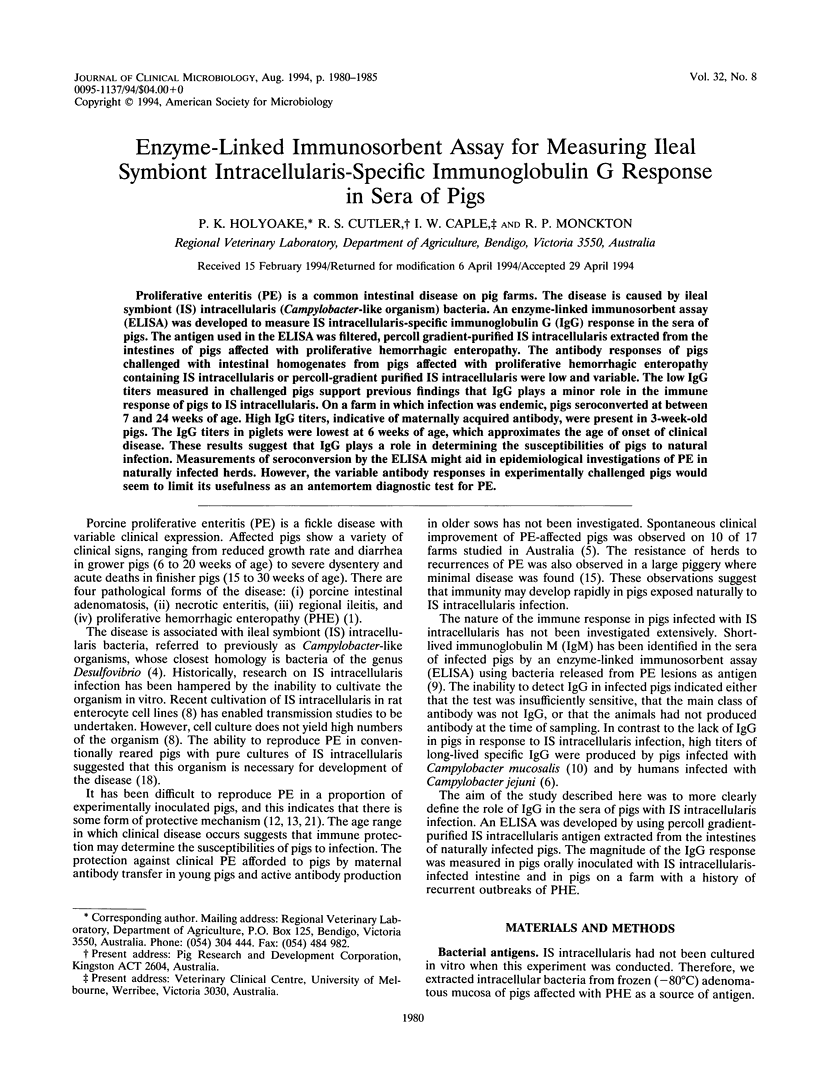
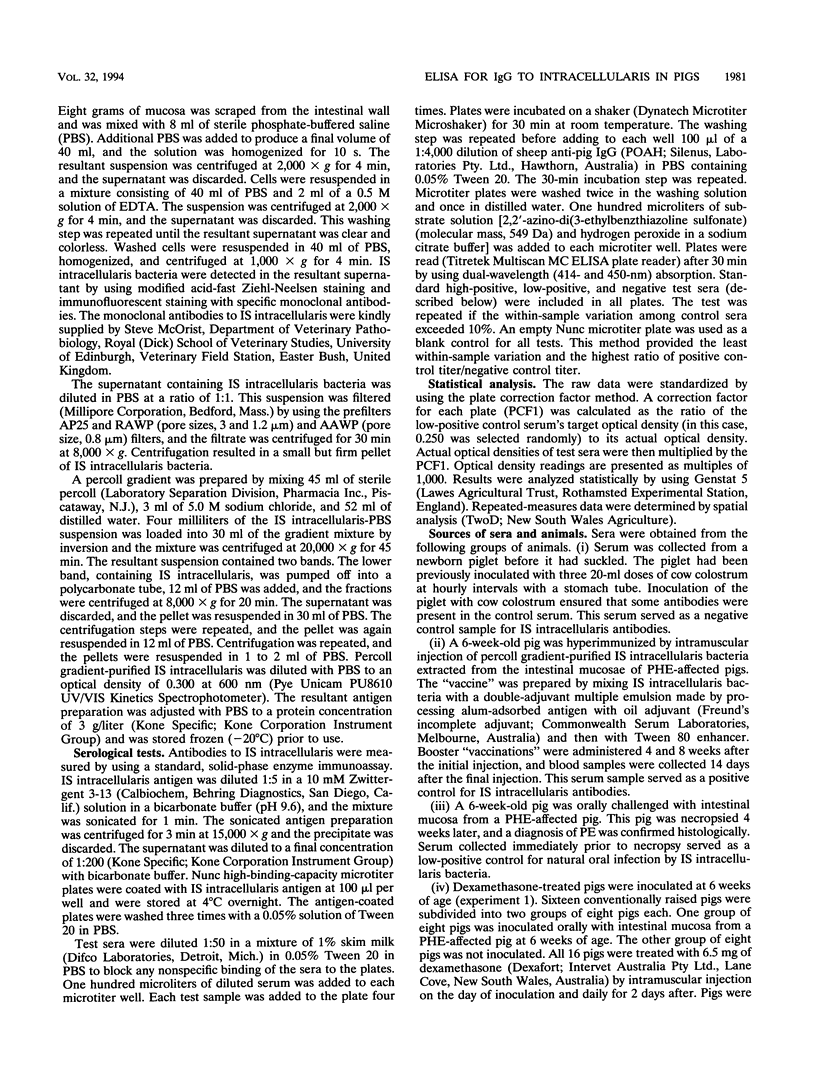
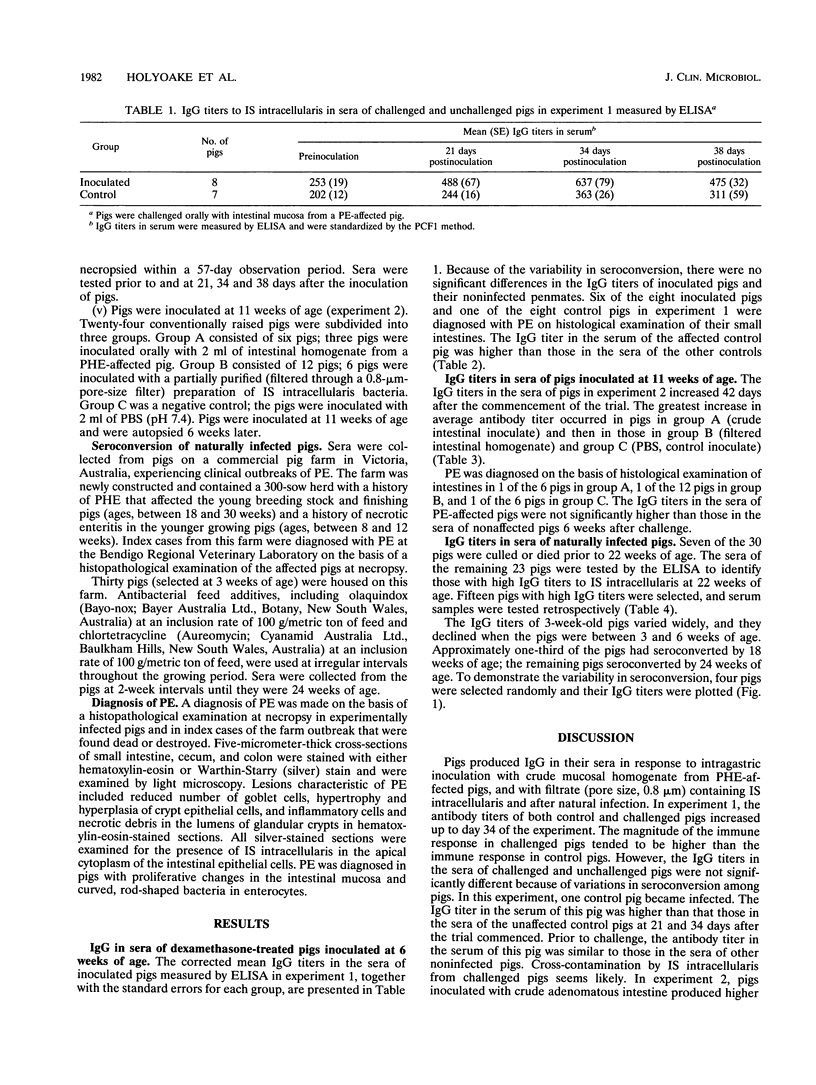
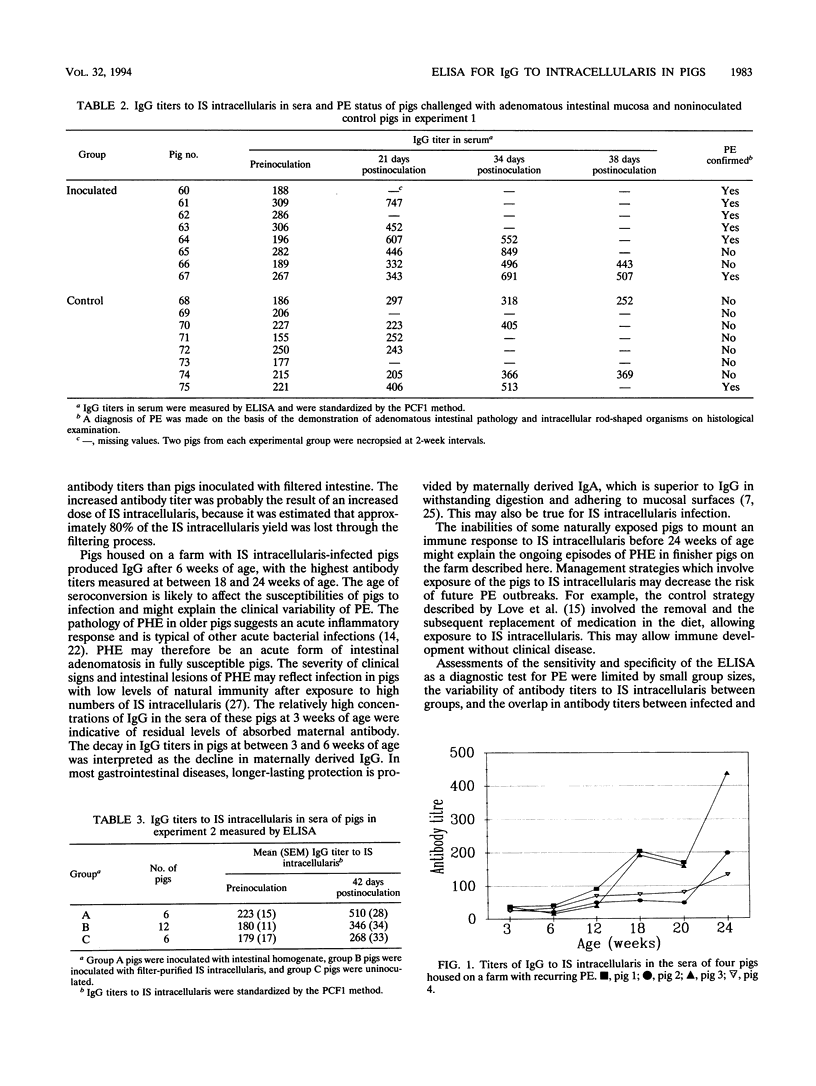
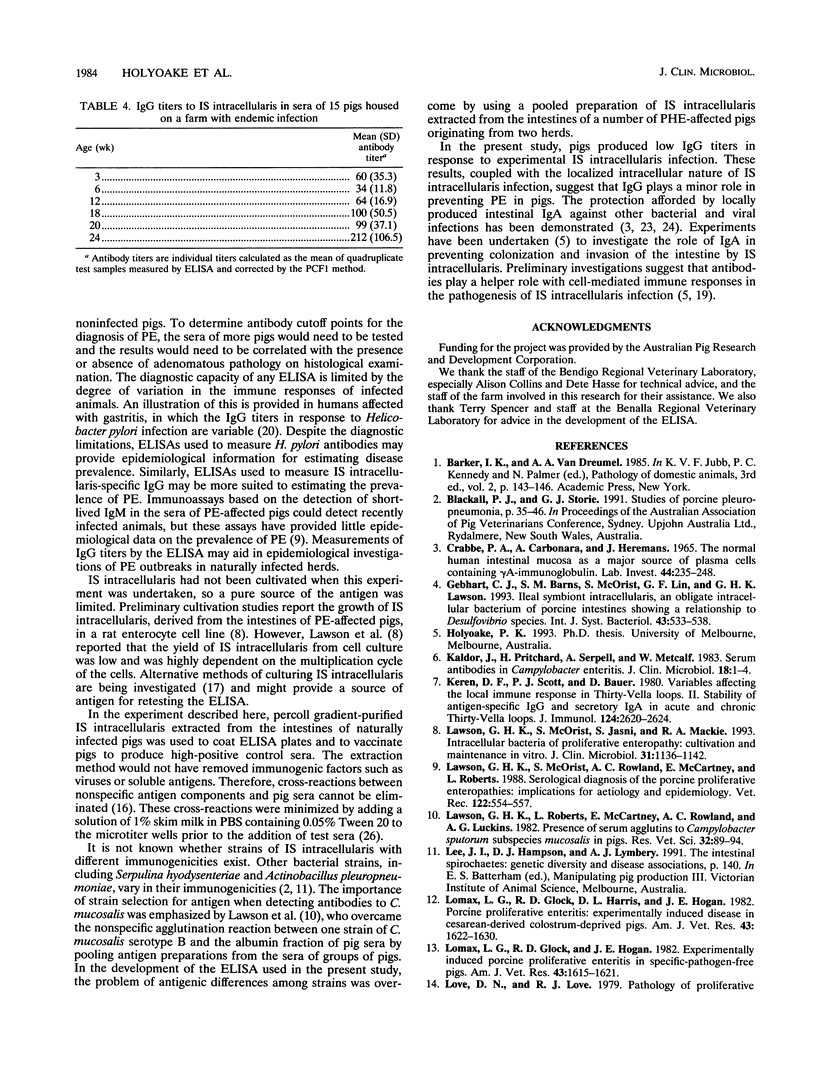
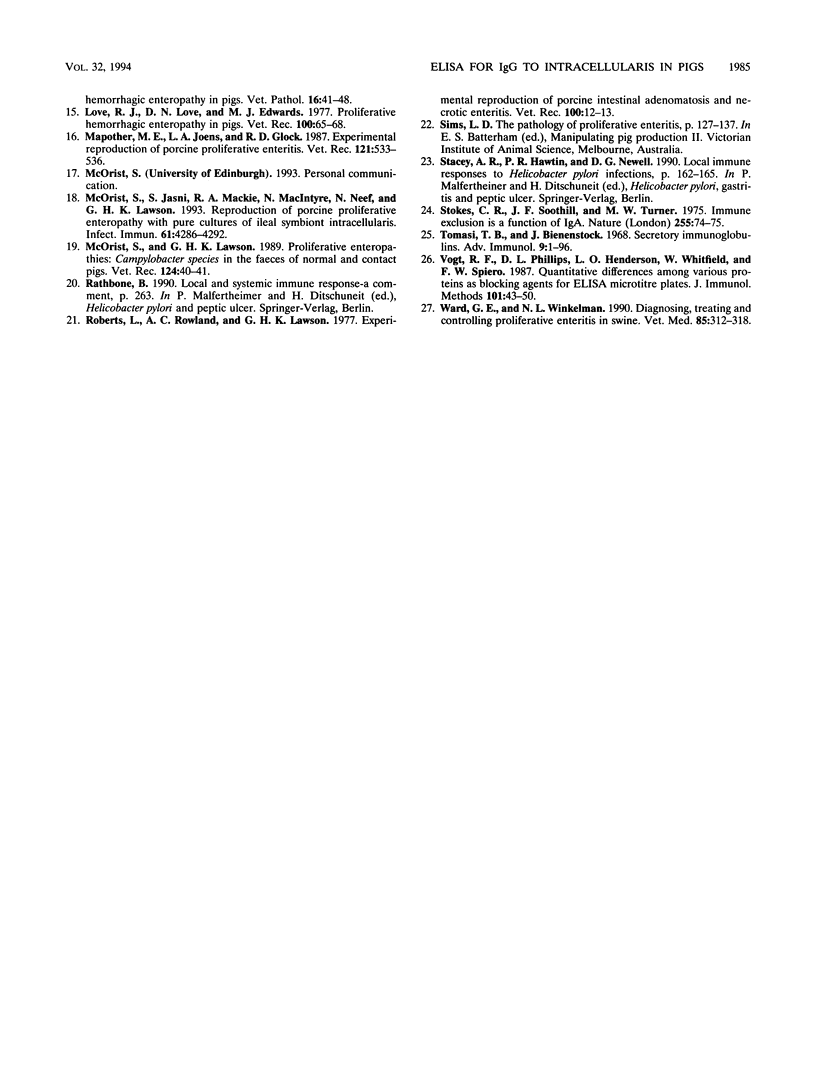
Selected References
These references are in PubMed. This may not be the complete list of references from this article.
- CRABBE P. A., CARBONARA A. O., HEREMANS J. F. THE NORMAL HUMAN INTESTINAL MUCOSA AS A MAJOR SOURCE OF PLASMA CELLS CONTAINING GAMMA-A-IMMUNOGLOBULIN. Lab Invest. 1965 Mar;14:235–248. [PubMed] [Google Scholar]
- Gebhart C. J., Barns S. M., McOrist S., Lin G. F., Lawson G. H. Ileal symbiont intracellularis, an obligate intracellular bacterium of porcine intestines showing a relationship to Desulfovibrio species. Int J Syst Bacteriol. 1993 Jul;43(3):533–538. doi: 10.1099/00207713-43-3-533. [DOI] [PubMed] [Google Scholar]
- Kaldor J., Pritchard H., Serpell A., Metcalf W. Serum antibodies in Campylobacter enteritis. J Clin Microbiol. 1983 Jul;18(1):1–4. doi: 10.1128/jcm.18.1.1-4.1983. [DOI] [PMC free article] [PubMed] [Google Scholar]
- Keren D. F., Scott P. J., Bauer D. Variables affecting the local immune response in Thiry-Vella loops. II. Stability of antigen-specific IgG and secretory IgA in acute and chronic Thiry-Vella loops. J Immunol. 1980 Jun;124(6):2620–2624. [PubMed] [Google Scholar]
- Lawson G. H., McOrist S., Jasni S., Mackie R. A. Intracellular bacteria of porcine proliferative enteropathy: cultivation and maintenance in vitro. J Clin Microbiol. 1993 May;31(5):1136–1142. doi: 10.1128/jcm.31.5.1136-1142.1993. [DOI] [PMC free article] [PubMed] [Google Scholar]
- Lawson G. H., McOrist S., Rowland A. C., McCartney E., Roberts L. Serological diagnosis of the porcine proliferative enteropathies: implications for aetiology and epidemiology. Vet Rec. 1988 Jun 4;122(23):554–557. doi: 10.1136/vr.122.23.554. [DOI] [PubMed] [Google Scholar]
- Lawson G. H., Roberts L., McCartney E., Rowland A. C., Luckins A. G. Presence of serum agglutinins to Campylobacter sputorum subspecies mucosalis in pigs. Res Vet Sci. 1982 Jan;32(1):89–94. [PubMed] [Google Scholar]
- Lomax L. G., Glock R. D., Harris D. L., Hogan J. E. Porcine proliferative enteritis: experimentally induced disease in cesarean-derived colostrum-deprived pigs. Am J Vet Res. 1982 Sep;43(9):1622–1630. [PubMed] [Google Scholar]
- Lomax L. G., Glock R. D., Hogan J. E. Experimentally induced porcine proliferative enteritis in specific-pathogen-free pigs. Am J Vet Res. 1982 Sep;43(9):1615–1621. [PubMed] [Google Scholar]
- Love R. J., Love D. N., Edwards M. J. Proliferative haemorrhagic enteropathy in pigs. Vet Rec. 1977 Jan 22;100(4):65–68. doi: 10.1136/vr.100.4.65. [DOI] [PubMed] [Google Scholar]
- Mapother M. E., Joens L. A., Glock R. D. Experimental reproduction of porcine proliferative enteritis. Vet Rec. 1987 Dec 5;121(23):533–536. [PubMed] [Google Scholar]
- McOrist S., Jasni S., Mackie R. A., MacIntyre N., Neef N., Lawson G. H. Reproduction of porcine proliferative enteropathy with pure cultures of ileal symbiont intracellularis. Infect Immun. 1993 Oct;61(10):4286–4292. doi: 10.1128/iai.61.10.4286-4292.1993. [DOI] [PMC free article] [PubMed] [Google Scholar]
- McOrist S., Lawson G. H. Proliferative enteropathies: Campylobacter species in the faeces of normal and contact pigs. Vet Rec. 1989 Jan 14;124(2):40–40. doi: 10.1136/vr.124.2.40. [DOI] [PubMed] [Google Scholar]
- Ong D. E., Chytil F. Specificity of cellular retinol-binding protein for compounds with vitamin A activity. Nature. 1975 May 1;255(5503):74–75. doi: 10.1038/255074a0. [DOI] [PubMed] [Google Scholar]
- Roberts L., Rowland A. C., Lawson G. H. Experimental reproduction of porcine intestinal adenomatosis and necrotic enteritis. Vet Rec. 1977 Jan 1;100(1):12–13. doi: 10.1136/vr.100.1.12. [DOI] [PubMed] [Google Scholar]
- Tomasi T. B., Jr, Bienenstock J. Secretory immunoglobulins. Adv Immunol. 1968;9:1–96. doi: 10.1016/s0065-2776(08)60441-1. [DOI] [PubMed] [Google Scholar]
- Vogt R. F., Jr, Phillips D. L., Henderson L. O., Whitfield W., Spierto F. W. Quantitative differences among various proteins as blocking agents for ELISA microtiter plates. J Immunol Methods. 1987 Jul 16;101(1):43–50. doi: 10.1016/0022-1759(87)90214-6. [DOI] [PubMed] [Google Scholar]


